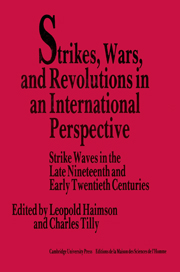 Strikes, Wars, and Revolutions in an International Perspective
Strikes, Wars, and Revolutions in an International Perspective Published online by Cambridge University Press: 25 March 2010
It is now generally accepted by historians that the First World War demanded the mobilization of people and resources that was not only unprecedented but largely incomprehensible in terms of prewar assumptions. It was generally expediency that dictated government policy, and the ad hoc way in which the state was forced inexorably to extend its scope of activity meant that major changes were set in motion, and in a context where there was little understanding of the principles of wartime mobilization, and even less of an appreciation of the social consequences that could have scarcely been anticipated. This was especially true of the engineering industry and its labor force, which has been so crucial to the demands of twentieth-century warfare. The engineering industry is defined to include all manner of metal fabrication, and thus would appear to encompass more than might be inferred from the term “munitions work,” which was a subsequent government-styled designation that has continued to confuse an understanding of the industry's development during the First World War. Despite difficulties of definition, one estimate shows that in munitions, as a whole, the male labor force rose from 1,869,000 in July 1914 to 2,309,000 by November 1918, while the female labor forces rose from 212,000 to 945,000 during the same period, which marks a total net increase of 1,200,000 workers. The growth in the number of women workers highlights the acute labor shortage during the war, as men were lost to the armed forces at the same time that existing productive capacity had to be increased and new lines established.
To save this book to your Kindle, first ensure [email protected] is added to your Approved Personal Document E-mail List under your Personal Document Settings on the Manage Your Content and Devices page of your Amazon account. Then enter the ‘name’ part of your Kindle email address below. Find out more about saving to your Kindle.
Note you can select to save to either the @free.kindle.com or @kindle.com variations. ‘@free.kindle.com’ emails are free but can only be saved to your device when it is connected to wi-fi. ‘@kindle.com’ emails can be delivered even when you are not connected to wi-fi, but note that service fees apply.
Find out more about the Kindle Personal Document Service.
To save content items to your account, please confirm that you agree to abide by our usage policies. If this is the first time you use this feature, you will be asked to authorise Cambridge Core to connect with your account. Find out more about saving content to Dropbox.
To save content items to your account, please confirm that you agree to abide by our usage policies. If this is the first time you use this feature, you will be asked to authorise Cambridge Core to connect with your account. Find out more about saving content to Google Drive.